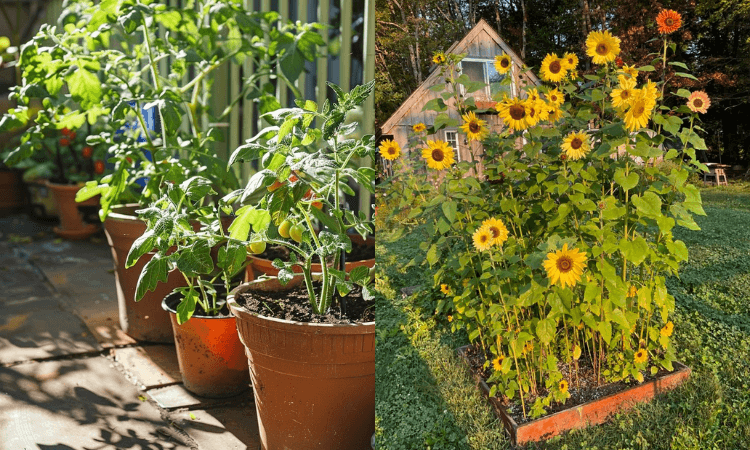Gardening is a rewarding and calming hobby that allows you to connect with nature, enjoy fresh produce, and beautify your space. Planning a garden can be simple, even for beginners, with the right approach. The key is to start small, focus on the basics, and choose plants that are easy to care for. This guide will walk you through the steps to plan a simple garden that suits your space, needs, and skills.
Get Started with the Right Location
The first step in planning any garden is choosing the right location. The space you pick will determine how well your plants grow, so it’s important to assess your garden’s environment.
Choosing the Best Spot for Your Garden
To begin, you need to evaluate the sunlight your garden will receive. Most plants require at least 6 hours of direct sunlight a day, so find a spot that gets plenty of sun. However, some plants thrive in shaded areas, so you’ll want to consider your plant selection when deciding where to place your garden.
- Look for an area with full sun for most vegetables.
- Consider a shaded spot for leafy greens or herbs.
- Avoid areas with strong winds or heavy traffic that could harm plants.
Understanding the Growing Conditions
Once you’ve chosen the location, take a look at your soil. Different plants need different types of soil. You can improve your soil by adding compost or mulch, which helps retain moisture and provides nutrients.
- Test the soil’s pH to see if it’s too acidic or alkaline.
- Add organic compost to improve texture and fertility.
- If needed, adjust the soil with fertilizers suited to your plants.
Selecting the Right Plants

Selecting the right plants is crucial to creating a successful garden. Beginners should start with plants that are easy to grow and require little maintenance. Keep in mind your climate zone, the amount of space you have, and how much time you’re willing to invest.
Easy-to-Grow Plants for Beginners
Some plants are perfect for first-time gardeners because they’re low-maintenance and grow quickly. Here are a few options to consider:
- Tomatoes: These are hearty and rewarding plants that grow well in sunny spots.
- Sunflowers: Easy to grow and provide a cheerful touch to any garden.
- Herbs: Basil, mint, and parsley are perfect for small spaces and require minimal care.
- Lettuce: Grows quickly and is perfect for beginners with limited space.
Know Your Climate Zone
Before choosing your plants, make sure they are suitable for your climate. Different plants thrive in different zones, so it’s important to select plants that are adapted to the conditions where you live. Research your USDA Hardiness Zone or consult a local nursery to find out what grows best in your area.
- Check your zone before buying seeds or plants.
- Consider seasonal changes and weather patterns.
- Choose plants that are both drought-tolerant and frost-resistant.
Consider Plant Size and Growth Habit
When planning your garden, it’s important to consider how large your plants will grow. Some plants, like pumpkins, need a lot of space, while others, like herbs, can thrive in small containers.
- Small plants: Ideal for containers or small garden beds (e.g., herbs, strawberries).
- Medium plants: Best for larger spaces or raised beds (e.g., tomatoes, peppers).
- Large plants: Requires significant space, good for open garden areas (e.g., sunflowers, corn).
Simple Garden Layout Ideas
Now that you know where to plant and what to grow, it’s time to think about how to arrange your garden. A well-planned layout will help your plants get the light, water, and space they need.
Planning the Space Efficiently
When planning your garden, ensure there is enough space between plants. Overcrowding can lead to poor growth and disease. A simple layout might involve dividing your garden into different sections for different types of plants.
- Vegetable section: Space for plants like tomatoes, carrots, and beans.
- Herb garden: A small, contained area for herbs such as basil, parsley, and rosemary.
- Flower bed: Include flowers for beauty and to attract pollinators.
Companion Planting
Companion planting is a gardening strategy where certain plants are grown together to benefit each other. For example, planting marigolds next to tomatoes can help deter pests. This is a great way to make your garden more productive and reduce the need for chemical pesticides.
- Tomatoes and basil: Basil repels insects that harm tomatoes.
- Carrots and onions: Onions help keep pests away from carrots.
- Beans and corn: Beans use corn stalks as support while adding nitrogen to the soil.
Basic Garden Care and Maintenance
To ensure your garden grows healthy and strong, you’ll need to care for it regularly. Basic garden maintenance involves watering, fertilizing, and pruning.
Watering and Fertilizing
Watering is a crucial part of garden care. Most plants need consistent moisture, but it’s important not to overwater, as this can lead to root rot. Fertilizing helps provide your plants with the nutrients they need to grow strong.
- Water plants early in the morning to prevent evaporation.
- Use a soaker hose or drip irrigation to ensure deep watering.
- Apply a balanced fertilizer to promote healthy growth.
Pruning and Harvesting
Pruning helps your plants grow stronger and more productive. Be sure to remove dead or damaged leaves regularly. Additionally, harvesting your plants at the right time is essential to enjoying their full flavor.
- Prune dead leaves or stems to improve airflow.
- Harvest fruits and vegetables when they are fully ripe.
- Use clean tools to avoid transferring diseases.
Conclusion
Starting a garden as a beginner doesn’t have to be overwhelming. By following a simple plan, choosing easy-to-grow plants, and regularly maintaining your garden, you can create a thriving space that will bring you joy. Remember to take your time, start small, and learn as you go. Gardening is a journey, and with patience and care, you’ll soon be enjoying the fruits of your labor.



